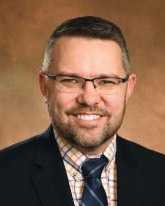Rural leaders build networks to source PPE for hospitals
 Benjamin Anderson, MBA, MHCDS, Colorado Hospital Association vice president of rural health and hospitals   John Henderson, Texas Organization of Rural and Community Hospitals president and CEO |
A volunteer pilot slam-locks the passenger door of his aircraft and gets in. Before COVID-19, that passenger berth carried patients in need of a ride from their rural location to vital health care appointments. Regional networks such as Angel Flight coordinated these flights with a roster of pilots willing to donate their time, aircraft, and fuel to get rural patients where they needed to go. But when the pandemic hit, these networks were forced to suspend patient flights to limit the spread of the virus. Instead, they began flying face shields, masks, sanitizer, and gowns to hospitals fighting local outbreaks.
Access to personal protective equipment (PPE) has become an urgent issue nationwide with unique challenges for rural hospitals. When demand for PPE increased exponentially in response to the COVID-19 pandemic, a shortage of PPE exposed the fragility of a supply chain that rural hospitals rely on for protecting front-line workers every day.
Hospital leaders are always working to maintain a stable supply of PPE for daily patient care, but the task becomes much more difficult during periods of surge capacity and PPE shortages. In times like this, having a regional network of hospitals and community leaders working together is key to addressing immediate needs and finding long-term solutions.
A nationwide PPE shortage
Benjamin Anderson, MBA, MHCDS, Colorado Hospital Association vice president of rural health and hospitals, is responsible for leading and developing statewide strategy for rural hospitals. “Back in March and April, supply chains were thrown into chaos and hospitals faced a national shortage of PPE. Since then we’ve been working hard to build and strengthen networks for procuring, distributing, and sharing PPE,” Anderson says.
John Henderson, Texas Organization of Rural and Community Hospitals president and CEO, works in collaboration with 161 rural Texas hospitals. “When the supply chain was turned upside down, we had rural Texas hospitals desperate for PPE — mostly masks, gloves, gowns, and hand sanitizer to protect front-line caregivers, doctors, and nurses. We’ve been able to fill most of those gaps in the past few months. However, the situation continues to evolve and now we’re having some difficulty securing test kits and reagents needed for COVID-19 testing,” Henderson says.
“We’re going to see shortages of PPE until we have a vaccine or herd immunity, and how we handle this problem in the long term will determine the outcome of rural health care in the U.S. This is a problem that affects rural hospitals uniquely,” Anderson says. “Some rural communities have been hit harder than others by COVID-19, with outbreaks linked to meatpacking plants and cases spreading faster per capita than in urban areas. An outbreak can be particularly devastating in a place where there’s no access to ICU care and ventilators.”
Rural hospitals and their communities were already struggling to survive before the COVID-19 crisis, and existing challenges with resources, supplies, and finances are intensified. Here’s look at some of the biggest challenges related to PPE sourcing.
- Supply chain issues. Access to PPE has been a concern from the outset of COVID-19, especially for independent hospitals at the end of the supply line. That’s why NRHA and its partners are attempting to “hack” the usual routes that leave rural last in line.
- Buying power/leverage. Even if rural and independent hospitals have access to PPE vendors, they may not have the buying power. “It’s hard when you’re a small independent hospital asking for 200 masks and priority is given to orders of 200,000,” Anderson says.
- Shortage of cash and storage. Hospitals would benefit from purchasing in larger quantities, but because of cash and space, have no way to house it. “Rural hospitals often don’t have the cash to stock 90-plus days of PPE. They buy what they can afford and what they can store, which might be a 30-day or 15-day supply,” Anderson says.
- Unpredictable conditions. “Delivery of supplies can be affected by weather in our state and we have to get creative about how we deliver supplies to remote areas,” Anderson says. This is a situation with which Henderson is also familiar.
- Risks of nontraditional suppliers. When traditional supply routes are not available, hospitals may take on the risk of working with suppliers who don’t have a proven track record. “There’s added risk and anxiety when making orders for PPE without knowing what is real or a scam and whether a supplier will come through with a shipment as promised,” Henderson warns.
Take inventory survey
Anderson is one of many who have partnered with NRHA staff to coordinate and implement the association’s COVID-19 Technical Assistance Center to support all rural health stakeholders in receiving critical resources, PPE supply chain assistance, and more. Take NRHA’s PPE inventory survey so we may help you prepare.
Responding with innovation
Hospital leaders and NRHA members have a valuable perspective on the evolving problems around sourcing PPE for rural hospitals in response to the COVID-19 crisis. Here’s an overview of solutions being developed to source PPE in rural hospitals.
- Buying in bulk. Rural hospitals can gain leverage by pooling resources across organizations to buy bulk shipments of N95 respirators, face shields, gloves, gowns, and other equipment. “Minimum order quantities are often out of reach for rural hospitals. Working together to aggregate orders can help meet those minimums and reduce costs,” Henderson says. NRHA is currently surveying rural PPE supply in order to coordinate this effort, and you can help by taking the survey located in the sidebar.
- Centralized distribution. Instead of waiting for shipments coming from across the world, having a framework for centralized distribution helps speed delivery and improve confidence in the fulfillment process. “We need to work together better to develop a domestic supply of PPE so it doesn’t take weeks to ship from across the world,” Henderson says. “It’s all about relationships — local, regional, statewide — and leveraging buying power. The goal is to have greater economies of scale and less dependence on FEMA and state governments.”
- Local production. Opportunities to partner with local businesses exist in communities where manufacturing has slowed due to the pandemic. “Manufacturing plants here in Texas and across the country were able to pivot and start making PPE. For example, a small airplane parts manufacturer in North Texas was able to keep workers employed by making PPE. When it’s possible to produce PPE locally, this changes everything with regard to distribution,” Henderson says.
- Exchange platforms. Rural leaders are encouraging exchange platforms and partnerships for sharing PPE. “We need to think strategically, regionally, and collaboratively about sourcing PPE. We’re seeing hospitals in Colorado resort communities developing sharing mechanisms for PPE. Hospitals with more cash to procure more PPE are helping their neighbors,” Anderson says.
- Angel flights. The Colorado Hospital Association partnered with Project CURE, Heart4Heroes, Angel Flight West, Angel Flight Central, and the Civil Air Patrol to create a distribution network that delivers critical supplies to remote hospitals in Colorado, Nebraska, and Kansas. “Heart4Heroes is a campaign focused on supporting our medical heroes in small and rural area hospitals, which do not have the same working capital or supply reserves as larger hospitals. Supplies are procured through Project CURE and distributed through Angel Flight, a nonprofit that usually provides air transport for passengers in need of medical treatment. Thousands of volunteer pilots have donated their planes, their gas, and their time to deliver shipments of PPE out to the nearest landing strip to these hospitals at no charge,” Anderson says. “They responded to requests from hospitals with dangerously low levels of PPE, with deliveries made by that afternoon or next day. At least 300 missions have been completed with 300,000 pieces of PPE delivered to rural hospitals in our region.”
Solving PPE shortages in the midst of a pandemic is a tall order, and it’s a time when we need to lean into our strengths as rural communities. “When rural leaders decide to engage in something together, mountains can be moved — and PPE is a mountain,” Anderson says. “NRHA and its membership are uniquely positioned to scale this mountain and be a significant part of problem-solving.”
“There’s strength in numbers,” Henderson says. “Anything we can do together will be better than us trying to solve these problems alone. Instead of waiting for the next iteration of this crisis, we’re working on solutions now so that we’ll be better prepared for what comes next.”
